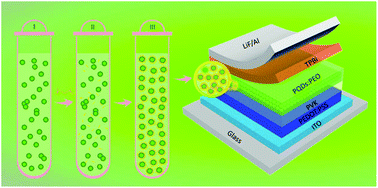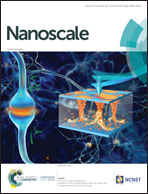A MAPbBr3:poly(ethylene oxide) composite perovskite quantum dot emission layer: enhanced film stability, coverage and device performance†
Abstract
Metal halide perovskite quantum dots (PQDs) have become the most promising optoelectronic material in new generation displays and lighting devices due to their excellent optical properties. However, their stability and surface defects have affected their large-scale applications. We demonstrate enhanced stability of high-surface-area colloidal PQDs encapsulated with long-chain organic polymer poly(ethylene oxide) (PEO) via simply mixing the PQDs with this high molecular-weight polymer. The introduction of the polymer deactivates the surface defects of PQDs and sufficiently protects the organic ligands on the surfaces of PQDs with obviously improved ambient stability and photoluminescence quantum yield. Moreover, the use of PEO efficiently confines electrons within the PQD emission layer and generates extremely stable green electroluminescence spectra in MAPbBr3 light-emitting diodes (LEDs) over a wide voltage operation range of 5–12 V, accompanied by significant improvements in external quantum efficiencies with enhancement factors of 18.3 times. Our work provides a robust platform for the fabrication of stable PQDs, high-quality PQD films and efficient PQD-based LEDs.



 Please wait while we load your content...
Please wait while we load your content...